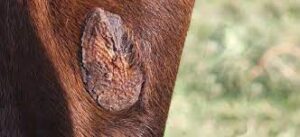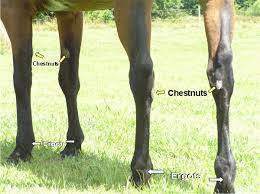paykwik al
online sportwetten
paykasa
paykwik
online sportwetten
paykasa
Horse Chestnuts
By Brian S. Burks, DVM
Diplomate, ABVP
Board Certified in Equine Practice
The chestnut, or night eye, is a callosity found on the inner side of the limb above the carpus on the foreleg and, if present, below the hock (tarsus) on the hind leg. It is believed to be a vestigial toe, and along with the ergot form the three toes of Eohippus, an early ancestor of the modern horse that lived roughly 50 million years ago. Eo means “dawn” and hippus means “horse,” so Eohippus is “dawn horse.”
Chestnuts vary in size and shape and are sometimes compared to the fingerprints in humans. For purposes of identification some breed registries require photographs of them among other individual characteristics. Because chestnuts grow over time and horse grooms often peel or trim off the outer layers for neatness, their appearance is subject to change.
Like human fingerprints, the basic outlines of the chestnuts are unique for each horse and are recognized by the Federation Equestre Internationale (FEI), the governing body of international equine competition, and other organizations as identifying marks. The FEI horse identification manual states, “The shape of a chestnut should be drawn in outline and related to the vertical.”
The evolution of the horse involved a reduction in the number of toes to one, along with other changes to the ancestral equid foot. The chestnut is thought to correspond to the wrist pad of dogs and cats, or to be a vestigial scent gland like those found in some deer and other animals. Carry the chestnut peelings of another horse into the paddock, and the horses there may come up to investigate, making catching easier. Many horses scratch their face or clean their eyes upon the chestnuts of the forelimbs.
The domestic horse is almost alone among extant equines in having chestnuts on the hind legs. Chestnuts are absent from the hind legs of donkey and zebras. The majority of domestic horses have chestnuts on all four legs, as does the Przewalski’s horse, but a few horse breeds are reported to lack chestnuts on the hind legs. These include:
- Banker horse (most individuals)
- Caspian pony (some individuals)
- Icelandic horse (most individuals)
Grooming
Chestnuts grow over time, protruding from the surface of the leg. Grooming for horse showing may include peeling or trimming the outer layers to give a neater appearance to the leg; they may peel more easily if softened first with baby oil or moisturizer, or if the horse is bathed first. If left alone, eventually the chestnut peels naturally. The layers close to the skin are sensitive; close trimming is not recommended.
One last fact: chestnuts are sometimes known as “night eyes.” The name may be based on an ancient but erroneous belief that the structures had visual abilities to help horses see their way around at night.












